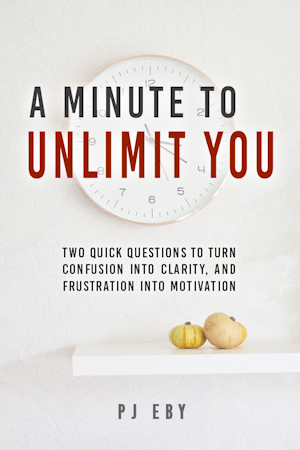In “Life is Every Moment”, I commented briefly on the problem of the procrastination cycle: first you get behind, then you catch up – and in the process get behind on something else. The next day after I wrote it, however, I had an insight as to what to do about it. That is, I figured out what to do instead. I’ve been using it for a couple of days now, and it seems to be going quite well.
Earlier this evening, however, I spent a couple of hours trying unsuccessfully to write an article to explain the concept. The problem is, it seems to resist explanation at article length, at least for me. I can explain it in a few sentences that will make you go, “oh, of course, duh”, following which you will then promptly ignore the idea because it’s clearly too simple to be any use whatsoever. Or, I could maybe write an entire book so as to conceal the simplicity of the idea enough to get people to actually try it.
But that wouldn’t be the only reason to write it in book form. The idea itself is rather fractal, and once you “get” it, it cascades out consequences over a wide variety of subject areas: health, finances, relationships, housekeeping, and time management in general – to name just the ones I’ve thought of so far. Certain aspects of David Allen’s Getting Things Done methodology can be viewed as manifestations of the idea and the principles that follow from it. Similarly, the same principles play a big part in Carol Keefe’s How to Get What You Want in Life with the Money You Already Have, and in the housekeeping practices of the “FLY Lady”.
Anyway, on the off chance that simply stating the ideas outright will help somebody without a lot of extra explanation, I’m going to just list a bunch of stuff in more-or-less outline form and let you try and sort it out. Remember, the hard part of this is that it’ s going to sound way too easy to be worth trying. But it’s the Simplest Thing That Could Possibly Work. Or things, actually, because there are two basic rules:
Rule 1: Don’t borrow without a repayment plan Rule 2: If you’re behind, make no effort to catch up!
Well, really, there is only one rule: manage your debts wisely, whether they are time or money. But that’s not specific enough to know what to do; the two-rule form is a little bit clearer. Still, the rules require explanations.
The first rule is pretty straightforward. You are never going to catch up if you borrow time and don’t have a way to pay it back. An example of borrowing time with a repayment plan is that you don’t wash every item of clothing when you take it off, but you have established a regular time at which you do laundry. This is the housekeeping equivalent of paying off your credit card each month.
As long as you have a system in place to make sure it gets done, then the debt is managed. The debt is unmanaged, however, if you are just going to do the laundry “whenever”. Problems ensue because “whenever” usually happens about the same time as everything else is going crazy.
The second rule is kind of counterintuitive. How can you catch up if you don’t try to catch up? The thing is, life is every moment. The life you have is the result of the process of how you live. If you want to live the life of somebody who isn’t behind, you need to stop trying to catch up, because people who aren’t behind don’t spend all their time trying to catch up! As a result, they then have time to do the things that need doing now, thus preventing them from ever getting behind!
When I realized this the other day, I joked to Leslie that I had converted to “paygoism”, because I became aware that I needed to “pay as I go”. Part of paying as you go is that you’re only paying for the maintenance of the things you have in your life now, not what you bought with borrowed time. Here’s a snippet of what Carol Keeffe’s book has to say about living on borrowed time, with some parenthetical comments I’ve added so the parallels are clearer:
When we make a payment on a credit card bill (try to catch up), we’re taking today’s money (time) and sending it off to pay for things we bought sometime in the past (whatever we did with the time instead). And, worse than that, using our credit cards (borrowing time) keeps us locked into the urge to pay off the card(“catch up”) first and then start to live. So long as we use credit, we’re choosing to put off living.
Thus, it is the very process of trying to catch up that keeps us locked into the guilt-and-repentance cycle around our uses of time and money!
Now note, by the way, that I said you should expend no effort in catching up, but this does not mean that you just ignore whatever debts you’ve accumulated. It simply means you set no goals to catch them up, no heroic efforts. You do not engage in a marathon effort to set them right. You simply notice in the moment when you can do something – pick up that thing, put something else away, pay a bill, do an exercise, whatever – and you do it. That’s all. No attachment to your ideals, and no blame for your not having lived up to them. The past is past; what matters is this moment.
Yes, it will take a long time to “catch up” on everything this way, but it is the only way to make it sure. Your backlog will never decrease as long as you’re putting more things on it, and pushing to catch one thing up will almost certainly add to your backlog somewhere.
However, if you “live within your time” by not borrowing what you can’t repay, then you will automatically have a surplus of time: the time you would’ve spent worrying about not being caught up, and the time you would’ve spent avoiding the work and trying not to think about it. You can then spend some of this surplus time on actually catching up, in very small increments.
I think the hardest part of this for most people is probably going to be overcoming the fear of giving up, or the fear that by taking this approach you will never be able to get caught up. If this is what you are feeling, you need to understand that it doesn’t matter how far the island is, you just need to keep swimming. If you believe you will reach the island, then in every moment you will be there.
In the last two days I’ve known the joy of being “caught up” even though I’m not really that much less behind than I was before. But now I know that I will get caught up eventually (because I’ve stopped getting further behind), and so I feel as if I’m already there. This same confidence is the goal of Allen’s GTD methods: the security of knowing that things will be handled, that everything is under control, and that nothing will be lost.
If you are interested in exploring these ideas further, I highly recommend first reading the Carol Keeffe book (which explains the psychology and techniques in relation to money and debt) and then the FLYLady site (which applies the concepts to housework, but doesn’t really discuss the theory any). I had previously read and used the Keeffe book to get out of (money) debt many years ago via this technique, but hadn’t thought of the idea in more general terms until this weekend.
Anyway, I read a bunch of stuff off the FLYLady site in the last week while researching anti-procrastination tricks, and tried to figure out the principles behind her program. At some point, I realized that the FLYLady’s “baby steps” were in effect a way of “making only minimum payments” on your “housework debt”, and that her “Control Journals” were basically a way to establish “revolving credit plans” for housework that is most efficiently done in batches (e.g. laundry), while ensuring that they are “paid off every month” (or day, or week, etc.).
At that point, it became clear to me that you could generalize the approach to anything in life that you feel is out of control or are frustrated with yourself about, and I’ve been happily doing just that.
Now, if you’ll excuse me, I’ve got to go make sure I don’t increase my sleep debt. 🙂 Good night, and good luck. Feel free to ask questions in the comments, and I’ll answer there or in another article, depending on the complexity of the answer.









Phillip,
While the idea is quite solid and appealing, a successful implementation must take into account the fact that constantly doing things (small increments) forces one to constantly face the “hold-backs” from doing things. Maybe that’s the best way to deal with feelings such as perfectionism, fear-of-failure, boredom etc… but it might prove quite hectic. What are your thoughts on that?
Gil
Phillipe,
For me, many of the principles you have written about resonate with
the ideas expressed by Byron Katie
in her book “Loving what is” and with a course I took many years
ago.
Byron Katie
Article in Time magazine
Keep the ideas coming.
“””constantly doing things (small increments) forces one to constantly face the “hold-backs” from doing things.”””
Yes, definitely. In the longer article, I was going to bring up this point, but had to omit it in this shorter treatment.
“””Maybe that’s the best way to deal with feelings such as perfectionism, fear-of-failure, boredom etc… but it might prove quite hectic. What are your thoughts on that?”””
So far, I haven’t encountered much of this. The debt metaphor works extremely well for me because I don’t like being in debt. So far, the idea that by putting something off I’m putting myself deeper in debt is enough to get me working on *something*, even if it’s not the thing I originally intended to.
I will have more to say on this subject soon, but if you want more in-depth answers fast, read Keefe’s book and just substitute “time” wherever she says “money”.
That’s what I’ve been doing as I’ve been rereading her book this evening, and it’s quite an eye-opener. (I hadn’t read it in years, since it pretty much solved my money problems using only a fraction of what was in it.)
Anyway, with that substitution, the book is actually a practical guide to implementing the philosophies I put forth in The Island Within and Life is Every Moment.
Some of the techniques require adjustments, of course, since you can’t save up bits of loose time and put them in jars, but there are still ways to translate them. More on this later.
“””For me, many of the principles you have written about resonate with
the ideas expressed by Byron Katie
in her book “Loving what is” and with a course I took many years
ago.”””
Looks interesting, I’ll have to investigate further. Thanks for the links.
Your link in the opening sentence is broken. (Life-is-Every-Moment) It has the domain twice.
I’ve fixed it now. Thanks.
PJE wrote: “I’m going to just list a bunch of stuff in more-or-less outline form and let you try and sort it out.”
Good. This is the Simplest Thing That Could Possibly Work (TM), and is definitely more useful than the Pierre de Fermat Pattern (“I have had a wonderful revelation but the margins of this blog are too small to accommodate it”) or the Frustrated Polymath Pattern (“I have had a wonderful revelation, but I don’t want to do less than justice to it, so you’ll have to wait while I try to reconcile it with all the other memes I’m currently hosting.”)
🙂
PJE wrote “… researching anti-procrastination tricks …”
Can be a fun way to put off Doing What Can Be Done Now.
🙂
In addition to the good points made in your article:
I generally find that, recurring clutter consists of stuff that I haven’t consciously assigned a home to yet. ie. the “too hard basket” stuff.
“Doing it as you go” works for routine maintenance, but I find it’s often the stuff that you don’t have a routine for that’s the real stumbling block.
I didn't even read to the end, but promise I will. Many times I have thought about chucking everything I am "behind" on and I just can't pull the trigger. I hope you answer that for me later in the column/blog/article.